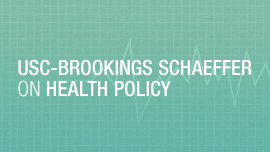What’s the latest in health policy research? The Essential Scan, produced by the Schaeffer Initiative for Innovation in Health Policy, aims to help keep you informed on the latest research and what it means for policymakers. If you’d like to receive the biweekly Essential Scan by email, you can sign up here.
Interdisciplinary pain management systems should be part of policy discussion to stem opioid use
Jason Doctor, Daniella Meeker, Joan Broderick, and co-authors outline three feasible policy initiatives aimed at providing better care to patients with chronic pain while reducing use of prescription opioids in Health Affairs Blog. The researchers outline the following policy initiatives in their paper: the establishment of interdisciplinary approaches to pain management with the leadership of CMS, implementation of electronic decision aids to trigger default therapy schedules, and new training schedules that include state-of-the-art approaches to pain management. As policymakers grapple with how to curb opioid use and misuse across the country, initiatives aimed at managing chronic pain- the reason many patient start opioids- is imperative. Full article here.
 Kelsey Avery, Kenneth Finegold, and Amelia Whitman found relative reductions in the uninsured rate of 37 to 48 percent across all income groups from 2010 to 2015 – the group ranging 100 to 125 percent of the federal poverty level had the greatest relative decline at 48 percent in an ASPE Issue Brief. When analyzing uninsured rates by race and ethnicity since the passage of the Patient Protection and Affordable Care Act, the researchers found relative reductions of 35 to 59 percent. Yet, another ASPE Data Point estimated that 6.9 million individuals continue to purchase individual market insurance coverage off the health exchanges, even though 2.5 million of those could qualify for subsidies for on-exchange coverage and an additional 1.9 million might qualify for Medicaid or fall in the coverage gap in non-exchange states. These findings highlight the significant progress that has been made, but that there’s still room to make gains on health insurance access and affordability through Medicaid expansions and further outreach. Full issue brief here and data point here.
Kelsey Avery, Kenneth Finegold, and Amelia Whitman found relative reductions in the uninsured rate of 37 to 48 percent across all income groups from 2010 to 2015 – the group ranging 100 to 125 percent of the federal poverty level had the greatest relative decline at 48 percent in an ASPE Issue Brief. When analyzing uninsured rates by race and ethnicity since the passage of the Patient Protection and Affordable Care Act, the researchers found relative reductions of 35 to 59 percent. Yet, another ASPE Data Point estimated that 6.9 million individuals continue to purchase individual market insurance coverage off the health exchanges, even though 2.5 million of those could qualify for subsidies for on-exchange coverage and an additional 1.9 million might qualify for Medicaid or fall in the coverage gap in non-exchange states. These findings highlight the significant progress that has been made, but that there’s still room to make gains on health insurance access and affordability through Medicaid expansions and further outreach. Full issue brief here and data point here.
 “These figures also show how a program that only penalizes poor performers misses many opportunities to reduce readmissions compared to an alternative design that would reward or penalize all hospitals with readmission rates below or above what might be expected based on their case mix.” – Paul Ginsburg, PhD, Director of the Schaeffer Initiative
“These figures also show how a program that only penalizes poor performers misses many opportunities to reduce readmissions compared to an alternative design that would reward or penalize all hospitals with readmission rates below or above what might be expected based on their case mix.” – Paul Ginsburg, PhD, Director of the Schaeffer Initiative
Christina Boccuti and Giselle Casillas found that 83 percent of Medicare patient admissions were at hospitals receiving little to no penalty under the Hospital Readmissions Reduction Program (HRRP), the ACA program created to penalize hospitals for having relatively high rates of patient readmissions for specific health problems according to a Kaiser Family Foundation Issue Brief. Only 2 percent of admissions were at hospitals receiving penalties between 2 and 3 percent, and only 0.5 percent of beneficiary admissions were at hospitals receiving the maximum 2015 penalty of a 3 percent. Major teaching hospitals and those with higher shares of low-income beneficiaries were more likely to incur penalties. These findings raise policy questions as to whether, over time, the HRRP can effectively improve readmissions rates at the poorest performing hospitals, as well as whether an across-the-board reduction in Medicare payments is appropriate, given the lower share of admissions among poor-performing hospitals. Full issue brief here.
Laura A. Dummit, Daver Kahvecioglu, Grecia Marrufo and co-authors found that bundled payments for lower extremity joint replacement reduced costs to Medicare without significantly impacting quality. Publishing in JAMA, the authors evaluated over 120,000 episodes of care over the baseline and intervention periods at Bundled Payments for Care Improvement (BPCI) Initiative-participating hospitals and non-participants, finding that BPCI-participating hospital payments declined by an additional $1,166 over those not participating and had no significant differences in quality performance. In the Initiative’s second year report by The Lewin Group, such orthopedic episodes, like lower extremity joint replacement, were found to be one of the “select clinical episode groups”-of 48 clinical episode groups in total-with “modest reductions in Medicare episode payments.” While the BPCI Initiative is voluntary and new mandatory bundled payment programs are coming down the pike, these findings challenge health care payers to compare the impact of bundled payments in voluntary and involuntary settings, as well as to consider the types of care services for which bundled payments may meaningfully improve value. Full JAMA article here, and Lewin Group report here.
The Essential Scan is produced by the Schaeffer Initiative for Innovation in Health Policy, a collaboration between the Center for Health Policy at the Brookings Institution and the USC Schaeffer Center for Health Policy & Economics.
The Brookings Institution is committed to quality, independence, and impact.
We are supported by a diverse array of funders. In line with our values and policies, each Brookings publication represents the sole views of its author(s).






Commentary
The essential scan: Top findings in health policy research
October 7, 2016